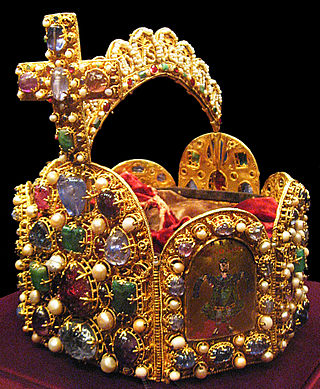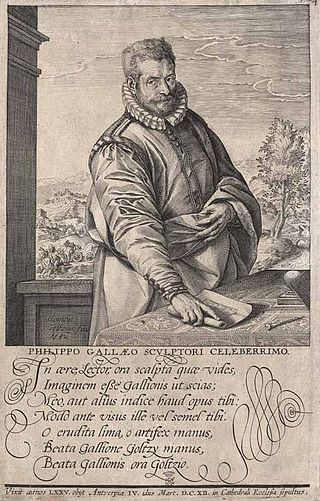
An icon is a religious work of art, most commonly a painting, in the cultures of the Eastern Orthodox, Oriental Orthodox, and Catholic churches. They are not simply artworks; "an icon is a sacred image used in religious devotion". The most common subjects include Jesus, Mary, saints, and angels. Although especially associated with portrait-style images concentrating on one or two main figures, the term also covers most of the religious images in a variety of artistic media produced by Eastern Christianity, including narrative scenes, usually from the Bible or the lives of saints.

Numismatics is the study or collection of currency, including coins, tokens, paper money, medals and related objects.

The Holy Roman Emperor, originally and officially the Emperor of the Romans during the Middle Ages, and also known as the Roman-German Emperor since the early modern period, was the ruler and head of state of the Holy Roman Empire. The title was held in conjunction with the title of king of Italy from the 8th to the 16th century, and, almost without interruption, with the title of king of Germany throughout the 12th to 18th centuries.

The House of Gonzaga is an Italian princely family that ruled Mantua in Lombardy, northern Italy from 1328 to 1708. They also ruled Monferrato in Piedmont and Nevers in France, as well as many other lesser fiefs throughout Europe. The family includes a saint, twelve cardinals and fourteen bishops. Two Gonzaga descendants became empresses of the Holy Roman Empire, and one became queen of Poland.

The Imperial Crown of the Holy Roman Empire, a hoop crown with a characteristic octagonal shape, was the coronation crown of the Holy Roman Emperor, probably from the late 10th century until the dissolution of the Holy Roman Empire in 1806. The crown was used in the coronation of the King of the Romans, the title assumed by the Emperor-elect immediately after his election. It is now kept in the Imperial Treasury at the Hofburg in Vienna, Austria.
Carausius II is the name given by historians to a possible imperial usurper in Roman Britain between the years 354 and 358. The suggestion of Carausius' existence comes exclusively from the study of approximately twenty extant coins, all of which were found in the United Kingdom. No other evidence of Carausius II is known, although Roman Britain at the time was an unstable and dangerous place and pretenders to the throne were likely.

PhilipGalle was a Dutch publisher, best known for publishing old master prints, which he also produced as designer and engraver. He is especially known for his reproductive engravings of paintings.

Otto van Veen, also known by his Latinized names Otto Venius or Octavius Vaenius, was a painter, draughtsman, and humanist active primarily in Antwerp and Brussels in the late 16th and early 17th centuries. He is known for his paintings of religious and mythological scenes, allegories and portraits, which he produced in his large workshop in Antwerp. He further designed several emblem books, and was from 1594 or 1595 to 1598 the teacher of Rubens. His role as a classically educated humanist artist, was influential on the young Rubens, who would take on that role himself. He was court painter of successive governors of the Habsburg Netherlands, including the Archdukes Albert and Isabella.

The erudite Augustinian Onofrio Panvinio or Onuphrius Panvinius was an Italian historian and antiquary, who was librarian to Cardinal Alessandro Farnese.

Charles III de Croÿ was Seigneur de Croÿ, 4th Duke of Aarschot, 5th Prince of Chimay and 5th Count of Beaumont. He played an important role on both sides of the Dutch Revolt. He was an avid collector of art and coins. His favourite residences were the Château de Beaumont and Heverlee castle, where he housed his collections and created beautiful gardens.

Jacopo Strada was an Italian polymath courtier, painter, architect, goldsmith, inventor of machines, numismatist, linguist, collector, and merchant of works of art. His portrait by Titian has kept his image familiar.

Prima pars Promptuarii iconum insigniorum à seculo hominum, subiectis eorum vitis, per compendium ex probatissimis autoribus desumptis. or Promptuarium Iconum Insigniorum for short is an iconographic collection of wood engravings authored and published by French humanist, numismatist, publisher and bookseller Guillaume Rouillé in Latin, French and Italian in 1553, in Lyon, France. The book's initial editions contain 828 portraits, designed as medallions, of figures some of whom are mythical and some historical. The portraits are listed in chronological order, beginning with those of Adam and Eve and ending with those of renowned individuals from the mid-16th century, each accompanied by a summarized biographical text. In a 1577 edition, approximately 100 more portraits were added.

Hubert Goltzius or Hubertus Goltzius, latinized form of Hubrecht Goltz or Hubert Goltz was a Renaissance painter, engraver, publisher, printer and numismatist from the Habsburg Netherlands. He was also active as an art and antique dealer. He was the great-uncle of the now better known engraver and painter Hendrik Goltzius. He is now recognized mainly for his contribution to numismatics and has been referred to as the 'father of ancient numismatics'.
Verdussen was a dynasty of printers in Antwerp, starting with Hieronymus Verdussen I in the late sixteenth century, and ending around 1800. Many other printers in Antwerp were also related to the Verdussens through marriage. They specialized in religious works and works in Spanish, but also published newspapers, almanachs, poetry, scientific works, .... By the end of the 17th century, they produced about 21% of the Spanish books printed in the Netherlands, and with 5 presses was second only to Moretus in Antwerp. In 1876, the Verdussenstraat was named after the family in Antwerp.

Barclay Vincent Head was a British numismatist and keeper of the Department of Coins and Medals at the British Museum.

Albert Rubens (1614–1657), was the eldest son of Peter Paul Rubens and Isabella Brant. His research as a philologist and scholar of antiquity gained him the recognition of fellow scholars throughout Europe. He held an official position in the government of the Habsburg Netherlands as a secretary of the Privy Council of the Habsburg Netherlands.
The New Generation Currency (NGC) Series is the name used to refer to Philippine peso banknotes issued since 2010 and coins issued since 2018. The series uses the Myriad and Twentieth Century typefaces.

Jacob de Bie, known in France also as Jacques de Bie was a Flemish engraver, publisher and numismatist who worked in Antwerp, Brussels, Paris and Arnhem. As a reproductive artist he made engravings after designs of other artists of his generation. He was engaged in numismatic collecting and categorisation and was an official at the mint in Brussels. He is now mainly known for his publication of portraits of French kings.

Johannes Schott was a book printer from Strasbourg. He printed a large number of books, including tracts from Martin Luther and other Reformers. He was a well-educated man, who had relationships with some of the leading humanists of his time. His press also was one of the first to be able to print chiaroscuro woodcuts.

















